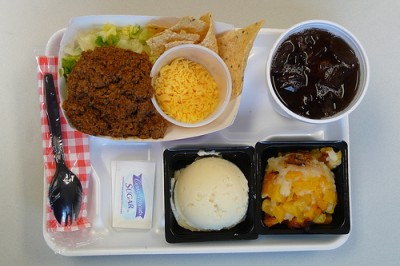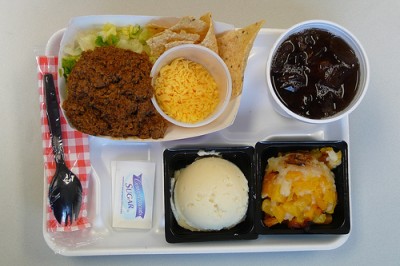Ed Bruske recently spent a week in the kitchen at H.D. Cooke Elementary School in the District of Columbia observing how food is prepared. This is the second of a six-part series of posts about what he saw. Read parts 1, 3, 4, 5, and 6. Cross-posted from The Slow Cook. And check out the rest of the Cafeteria Confidential series.
 Tuesday morning I arrived in the kitchen at H.D. Cooke Elementary School and was surprised to find scrambled eggs on the steam table. How is that, I wondered, when so much of the food served to students starts in the freezer? I had not seen any fresh eggs — or even any egg products — anywhere in my travels around the kitchen. Plus, there is no cooktop in the school kitchen, only a convection oven and a steamer, meaning nowhere to scramble eggs.
Tuesday morning I arrived in the kitchen at H.D. Cooke Elementary School and was surprised to find scrambled eggs on the steam table. How is that, I wondered, when so much of the food served to students starts in the freezer? I had not seen any fresh eggs — or even any egg products — anywhere in my travels around the kitchen. Plus, there is no cooktop in the school kitchen, only a convection oven and a steamer, meaning nowhere to scramble eggs.
I had a lot to learn about just how much our industrial food system can do with modern technology to eliminate the work we normally associate with food preparation, as well as the distance between the farms where food is grown and the people who eat it. In fact, the eggs had been cooked in a factory in Minnesota, then shipped frozen in six-pound plastic bags to the District of Columbia. Getting them to the breakfast line where they could be served to the approximately 150 students who participate in the school’s breakfast program was a simple matter of dumping the frozen eggs out of their bags and into stainless pans, then heating them in the kitchen’s commercial steamer.
The “scrambled” eggs come out looking more like pale yellow cottage cheese. According to the nutrition label on the box from Michael Foods in Minnetonka, Minnesota, they are made with “whole eggs, skim milk, soybean oil, modified corn starch, xanthan gum, liquid pepper extract, citric acid, natural and artifical butter flavor, lipolized butter oil, medium chain triglycerides, natural and artificial flavors.”
Kitchen manager Tiffany Whittington likes to stir cheddar cheese — pre-shredded by Land O Lakes in five-pound bags — into the scrambled eggs to boost the flavor quotient.
It’s not just scrambled eggs that seem to defy the usual laws of culinary physics. I noticed that the school sometimes serves egg salad. Being a fan of egg salad myself (I use a convoluted method for cooking the eggs so that they peel easily and maintain a pristine yolk), I asked Whittington where she got the hard-boiled eggs to make it. “Oh, the eggs come frozen, already diced,” she said with a wave of her hand. She just adds mayonnaise and seasonings to finish them off.
Recently I spent a week in the H.D. Cooke kitchen to observe how food is prepared. The company contracted to provide food for D.C. Public Schools, Chartwells-Thompson, part of a huge, international food service conglomerate called Compass Group, this year decided to eliminate pre-cooked, pre-packaged warmup meals from the school routine and introduce something they call “fresh cooked,” meaning meals prepared on-site in school kitchens. (The city’s charter schools contract independently for food service, usually with small catering companies.)
What I quickly learned is that “fresh cooked” does not mean “from scratch” or “fresh ingredients.” Indeed, most meals at H.D. Cooke are constructed around foods that have been heavily processed and reconstituted in distant factories, then shipped pre-cooked and frozen. Meal components have been industrially designed to require the least amount of time and minimal skill to prepare. It’s all part of an institutionalized effort to hold down costs — especially labor costs, which constitute half the cost of school food service — and squeeze school meals into tight local food budgets that hinge on subsidy payments from the federal government.
The result for a food manager such as Whittington is a kind of cook-by-numbers scheme that leans more toward kitchen administration than haute cuisine.
Whittington grew up in far Southeast Washington. After graduating from Ballou High School, she enrolled in a course with ServSafe, a national company that specializes in food service training and certification testing. She got a food service job in D.C. schools in 2001, and now supervises the work of two assistants who help assemble the food, serve it at the food line and maintain the kitchen and its equipment in immaculately clean condition.
Whittington keeps track of all the food, as well as a careful count of all the students who come through the food line. The numbers are critically important: for each student who qualifies, lunch is worth a $2.68 payment from the U.S. Deparmtment of Agriculture. Those federal payments cover most of the cost of food served in schools, or nearly half the total cost of food service operations. Local government picks up the rest.
Previously, meals for D.C. public schools were made in an off-site food factory and delivered to the schools in individual plastic containers, like airline food. When Chartwells switched to “fresh cooked,” it gave Whittington a recipe book for the new foods she would be serving. The book, a three-ring binder, contains dozens and dozens of single-page instructions for making large quantities of breakfast and lunch entrees, various side dishes and salads.There’s breakfast quesadilla, sweet and sour chicken, salisbury steak, Buffalo chicken wrap, “Big Daddy’s” cheese pizza, “fiesta rice,” glazed carrots, mashed potatoes, cole slaw, to name a few.
Most of the menu items consist of only a couple ingredients, and perhaps a three-step process for getting them to the steam table. For instance, lunch on Thursday was “Asian noodles” and “beef teriyaki bites.” The noodles were simply dry spaghetti pasta cooked in a steamer, then tossed with Kikkoman’s teriyaki sauce. The beef bites are small patties pre-cooked with an Asian-flavored glaze, imprinted with faux grill marks, then frozen by Pierre Foods in Cincinnati, Ohio. From their frozen state, they only need five minutes reheating in a 350-degree oven.
Sometimes the recipes are so simple that Whittington can put out breakfast for the entire school by herself. For breakfast grits, for instance, she heats a large pan of water to near boiling in the steamer, then stirs in Quaker “5-minute” grits from a box. While I watch her stir, I try to make conversation by talking about different styles of grits. Being from Chicago, I had never seen grits until I confronted them in the cafeteria at what was then the U.S. Department of Health, Education and Welfare, where I had a part-time job in college. Some people, I tell Whittington, like to cook their grits a long time from whole grains. Whittington looks at me with a quizical expression: She says she has not heard of long-cooked grits.
She finishes the instant grits by stirring in shredded cheddar cheese, which seems to be the go-to ingredient for flavor in the H.D. Cooke kitchen.
On Thursdays, Whittington sits down with her recipe book and the menu for the week ahead — the same menu for all of the school system’s elementary schools — sent via e-mail from Chartwells. After calculating the quantities of ingredients she needs, she fills out an electronic order form and sends it back to Chartwells. If all goes well, her order will be delivered the following Tuesday. The week I was there, there had been no delivery the previous Tuesday. Whittington did not know why, but it blew a huge hole in the published menu. Whittington simply improvised using the ingredients she had on hand.
One day the menu called for “Macho Nachos,” with turkey meat, corn chips and cheese sauce. Whittington had to substitute “beef crumbles” for the turkey meat, and she didn’t have the chips. I asked her why she couldn’t just call Chartwells and ask for an emergency delivery. She shook her head. “They would just have to find a school that has extra.” But not long afterwards she was on the phone with nearby Tubman Elementary School and arranged a trade: some of her extra cheese sauce for some of their chips. She drove off saying, “This better be enough!” and returned a short while later with three two-pound bags of corn chips and an eight-pound box of taco shells.
Add some Ore Ida “tater tots,” quickly heated in the convection oven, plus some Mission Pride fruit mix out of six-pound cans, and lunch was served.
The highly processed nature of school food concerns some food advocates. “Healthy Schools” legislation now pending before the D.C. Council would require the school system to publish the ingredients in all the foods it serves so that parents and others can see them. It would make a book: many of the nutrition labels on school food products read like chemistry experiments — only longer. You would also need an encyclopedia to know what the ingredients mean.
For instance, the toppings on one of the pizzas served at H.D. Cooke, something called “Smart Pizza” made by Schwan’s Food Service in Marshall, Minnesota, and shipped to the school frozen, lists the following ingredients: low moisure part-skim mozzarella cheese, mozzarella cheese substitute, cheese solids, modified food starch, rennet casein, sweet whey, non-fat dry milk, sodium aluminum phosphate, salt, carrageenan, magnesium oxide, ferric orthophosphate, modified food starch, sugar, dextrose, salt, spice, onion, dehydrated romano cheese, garlic powder, paprika, citric acid and beet powder.
“Teriyaki bites” on the school menu are made by Pierre Foods in Cinncinati, Ohio, which describes them as “fully cooked, flame-broiled, strip-shaped beef patties with teriyaki sauce.” The ingredients, which include commodity products from the U.S. Department of Agriculture, read as follows: ground beef, teriyaki sauce, sugar, water, distilled vinegar, modified food starch, pineapple juice concentrate, soybean oil, caramel color, xanthan gum, garlic powder, sodium benzoate, wine powder, natural rice wine flavor, textured vegetable protein product.”
On Tuesday the week’s provisions did in fact arrive and the freezer was suddenly full again — shelves filled with boxes, boxes stacked chest high in the row between the shelves. There was barely room to squeeze through. There were “turkey ham” slices, chicken patties and hot dogs, chicken nuggets and scrambled eggs. There were bags of sliced pepperoni for pizza, turkey sausage patties and boxes of potatoes in several different permutations: hash brown patties, potato wedges, tater tots, “breakfast cubes.” There was biscuit dough, pizza, muffins, juice cups and of course hamburgers with those familiar ersatz grill marks.
It looked like next week’s menu was assured. Now we just had to get through the rest of this week.
Next: Calling all vegetables.



